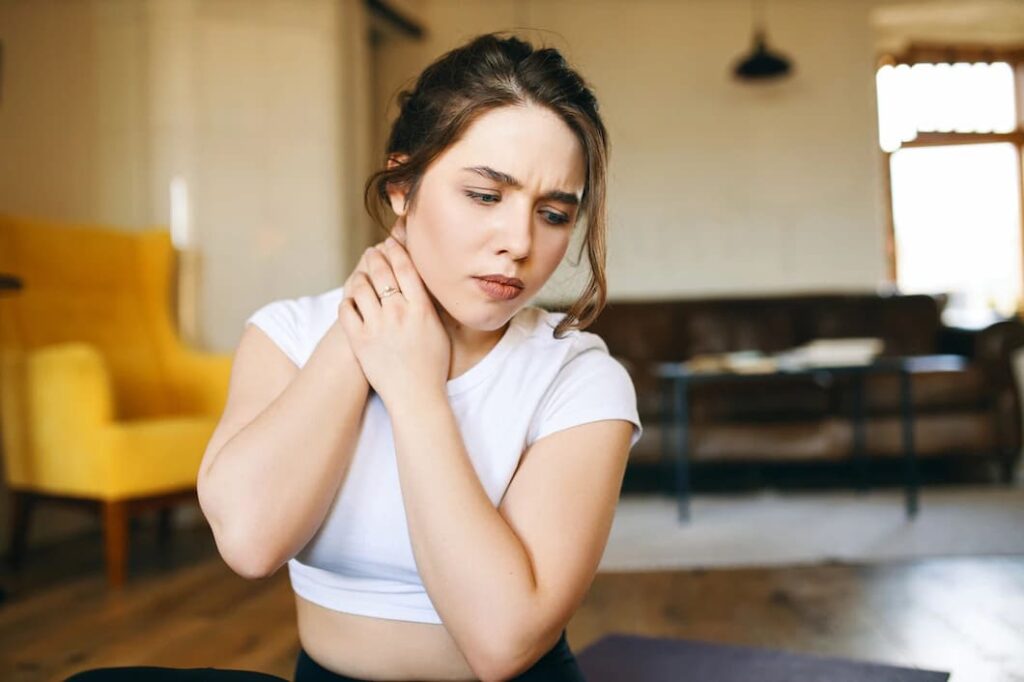Neck pain is common. Muscles, bones, joints, ligaments- any part of the neck may cause pain. Poor posture, osteoarthritis, and whiplash are common causes of neck problems. Neck strain can cause sharp pain. Neck strain and stiffness usually get better within a few days. But how to know if your neck pain is a result of some underlying condition that requires treatment? Some ways to tell the difference are listed below.
Days of pain or weeks of pain :
It is difficult to tell the difference whether neck pain is caused by strain or by a more serious condition. Cervical spine disorders or neck strain can cause neck pain ranging from mild to severe. It is important to note what is the duration of the pain, whether it has lasted for a few days or longer than a few weeks. The neck strain will get better within a few days or a few weeks. Cervical spine disorders last longer than a few weeks or may become worse.
Local and radiating pain :
The movement or location of the discomfort can also help doctors determine whether it is a neck strain or some other cervical spine disease. Pain from a neck strain is usually felt where soft tissues have been injured. Sometimes, the pain extends further up the neck or down to the shoulders. But most of the time, it stays local.
Pain from cervical spine conditions radiates toward the arm and hand. A spinal nerve root that has been compressed or inflamed, such as from foraminal stenosis or a herniated disc, is the cause of this radicular pain. Radiculopathy occurs when nerve root compression causes neurological deficits such as numbness or weakness. Radicular pain that radiates toward the arm may feel searing, shock-like, achy, or tingly. Radicular pain mostly occurs on one side of the body, but it can also occur on both sides.
Neck Cracking :
Most cracking or grinding sounds of the neck are normal. It may be more serious if certain neck movements consistently cause a cracking or grinding sound, which could be the result of bone-on-bone grinding. A chronic condition like osteoarthritis or an accident may be the reason why turning your head to the left always causes a clicking or grinding sound.
Most of the time neck strain heals on its own. Consult specialists of Specialty Care Clinics for treatment and learn ways to deal with pain.

WHAT HAPPENS WHEN YOU STRAIN THE NECK?
Seven vertebrae and an intricate system of soft tissues support the head and help in movement. The cervical spine is the most flexible part of the spine, but because of this mobility, it is also more prone to injury and strain. Strains are soft tissue injuries that affect muscles and tendons. Although the cervical vertebrae are reinforced by these soft tissues, they can still be injured if they are overworked or pressured. When combined with poor posture and movement mechanics, excessive flexion (bending forward) and extension (stretching out) activities can result in injury.
HOW TO DIAGNOSE NECK STRAIN?
Your doctor may check your reflexes and examine you for numbness and weakness in order to diagnose your issue. To confirm a diagnosis and check additional serious conditions, X-rays or CT scans may be required. To check muscle issues, electromyography is performed. The doctor may measure your neck’s range of motion, palpate your spine to look for inflammation or muscle spasms, or examine your sensory and motor responses neurologically.
WHAT TREATMENT OPTIONS ARE AVAILABLE FOR NECK STRAIN?
Treatment options include conservative therapies such as ice or cold therapy, stretching and exercise, pain medication, anti-inflammatory drugs, physical therapy, artificial disc replacement, and microdiscectomy.

AT-HOME REMEDIES FOR NECK STRAIN
- If your doctor prescribed a neck brace (cervical collar) to reduce neck movement, wear it for the number of days as directed by your doctor. However, long-term use of a brace can weaken the neck muscles and worsen neck stiffness.
- You can use heat and ice therapy. You can use a heating pad for 15-20 minutes with a gap of 2-3 hours. Or you can take a warm shower. An ice pack can be used for 10 to 15 minutes every 2 to 3 hours.
- Take pain medicines as directed.
- Rub the area gently to promote blood flow and reduce pain. If it hurts, do not massage.
- Avoid taking any actions that could increase the pain. For a few days, relax.
- Sleep on a special neck pillow. Place it under your neck or you can use a rolled towel. Do not use a regular pillow with a neck pillow or rolled towel.
- Exercises to stretch and strengthen your neck and back can help you avoid future neck pain.
- Frequently change your positions. Don’t sit or stand too long in one position.
When to visit a doctor
Most neck strain pain can be managed with self-care methods including rest, ice, heat, mild stretching, massage, or over-the-counter NSAIDs.
Visit Specialty Care Clinics if:
- Neck pain is severe.
- Pain doesn’t improve within a few weeks.
- If you have neck pain that was caused by a serious accident or that is accompanied by troubling signs and symptoms like radiating pain, tingling, numbness, and arm weakness.
- Neck stiffness is accompanied by fever or headache.
